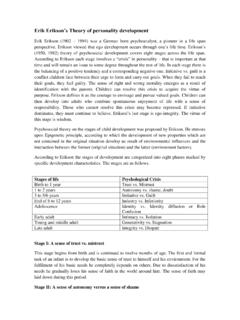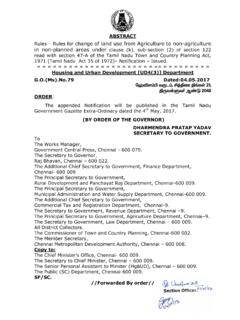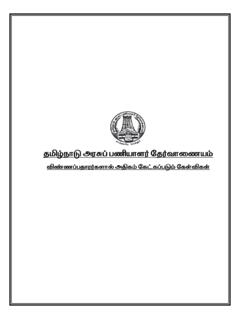Transcription of PANCHAYATI RAJ SYSTEMS IN INDIA - Surendranath College
1 PANCHAYATI RAJ SYSTEMS IN INDIA Edited by PRIYAM SARKAR Source : Wikipedia In INDIA , the PANCHAYATI Raj generally refers to the local self-government of villages in rural INDIA as opposed to urban and suburban municipalities, this system was introduced by a constitutional amendment in 1992. Although it is based upon the historical panchayat system of the Indian subcontinent. The recommendation of LM Singhvi Committee (1986) was accepted. This PANCHAYATI Raj system was formalized in 1992, following a study conducted by a number of Indian committees on various ways of implementing more decentralized administration. The modern PANCHAYATI Raj and its Gram Panchayats are not to be confused with the extra-constitutional Khap Panchayats (or Caste Panchayats) found in northern INDIA .
2 In INDIA , the PANCHAYATI Raj now functions as a system of governance in which gram panchayats are the basic units of local administration. The system has three levels: Gram panchayat (village level), Mandal Parishad or Block Samiti or panchayat Samiti (block level), and Zila Parishad (district level). It was formalized in 1992 by the 73rd amendment to the Indian Constitution. Currently, the PANCHAYATI Raj system exists in all states except Nagaland, Meghalaya, and Mizoram, and in all Union Territories except Delhi. The Panchayats receive funds from three sources: Local body grants, as recommended by the Central Finance Commission Funds for implementation of centrally sponsored schemes Funds released by the state governments on the recommendations of the State Finance Commission.
3 History of PANCHAYATI Raj System Mahatma Gandhi advocated PANCHAYATI Raj as the foundation of INDIA 's political system, as a decentralized form of government in which each village would be responsible for its own affairs instead, INDIA developed a highly centralized form of government. However, this has been moderated by the delegation of several administrative functions to the local level, empowering elected gram panchayats. There are significant differences between the traditional PANCHAYATI Raj system, that was envisioned by Gandhi, and the system formalized in INDIA in 1992. The panchayat Raj system was first adopted by the state of Rajasthan in Nagaur district on 2 Oct 1959 but first started by Andhra Pradesh.
4 During the 1950s and 60s, other state governments adopted this system as laws were passed to establish panchayats in various states. Maharashtra was the ninth state. It also founded backing in the Indian Constitution, with the 73rd amendment in 1992 to accommodate the idea. In the history of PANCHAYATI Raj, in INDIA , on 24 April 1993, the Constitutional (73rd amendment) Act 1992 came into force to provide constitutional status to the PANCHAYATI Raj institutions. This amendment was extended to Panchayats in the tribal areas of eight states, namely: Andhra Pradesh, Gujarat, Himachal Pradesh, Maharashtra, Madhya Pradesh, Odisha, and Rajasthan beginning on 24 December 1996.
5 List of committees constituted for recommendations regarding PANCHAYATI Raj in INDIA : Balwant Rai Mehta 1957 Krishnammachari 1960 Takhatmal Jain Study Group 1966 Ashok Mehta Committee 1978 Rao Committee 1985 Dr. Singhvi Committee 1986 Thungon Committee 1989 S. Mohinder Singh 2013 Balwant Rai Mehta Committee The Balwant Rai Mehta Committee, headed by MP Balwantrai Mehta, was a committee appointed by the Government of INDIA in January 1957 to examine the work of the Community Development Programme (1952) and the National Extension Service (1953), to suggest measures to improve their work. The committee's recommendation was implemented by NDC in January 1958, and this set the stage for the launching of PANCHAYATI Raj Institutions throughout the country.
6 The committee recommended the establishment of the scheme of democratic decentralization , which finally came to be known as PANCHAYATI Raj. This led to the establishment of a three-tier PANCHAYATI Raj system: Gram panchayat at the village level, panchayat Samiti at the block level, and Zila Parishad at the district level. 1. Gram panchayat sabha Sarpanch is its elected head. The members of the gram panchayat are elected from each for a period of five years by the members of Gram Sabha. Sources of income 1. Taxes collected locally such as on water, place of pilgrimage, local mandirs (temples), and markets 2. A fixed grant from the State Government in proportion to the land revenue and money for works and schemes assigned to the Parishads 3.
7 Donations 2. Block level panchayat or panchayat Samiti A panchayat Samiti (block panchayat ) is a local government body at the tehsil level. This body works for the villages of the tehsil that together are called a "development block". The panchayat Samiti is the link between the Gram panchayat and the district administration. Just as the tehsil goes by other names in various parts of INDIA , notably mandal and taluka, there are a number of variations in nomenclature for the block panchayat . For example, it is known as Mandal Praja Parishad in Andhra Pradesh, Taluka panchayat in Gujarat and Karnataka, and panchayat Samiti in Maharashtra. In general, the block panchayat has the same form as the gram panchayat but at a higher level.
8 Composition Membership in the block panchayat is mostly ex-official; it is composed of: all of the Sarpanchas (gram panchayat chairmen) in the panchayat Samiti area, the MPs and MLAs of the area, the sub-district officer (SDO) of the subdivision, co-opt members (representatives of the SC/ST and women), associate members (a farmer from the area, a representative of the cooperative societies and one from marketing services), and some elected members. The panchayat Samiti is elected for a tel Welfare Information Technology Water Supply Department Animal Husbandry and others Functions 1. Implementation of schemes for the development of agriculture and infrastructure 2.
9 Establishment of primary health centres and primary schools 3. Supply of clean drinking water, drainage and construction/repair of roads 4. Development of a cottage and small-scale industries, and the opening of cooperative societies 5. Establishment of youth organisations in INDIA 3. Zila parishad The governing of the advance system at the district level in panchayat Raj is also popularly known as Zila Parishad. The chief of administration is an officer of the IAS cadre and chief officer of the panchayat raj for the district level. Composition 1. Deputy Commissioner of the District 2. Presidents of all panchayat Samitis in the district 3.
10 Heads of all Government Departments in the district 4. members of Parliament and Members of Legislative Assemblies in the district 5. a representative of each cooperative society 6. some women and Scheduled Caste members, if not adequately represented. Functions 1. Provide essential services and facilities to the rural population 2. Supply improved seeds to farmers and inform them of new farming techniques 3. Set up and run schools and libraries in rural areas 4. Start primary health centers and hospitals in villages; start vaccination drives against epidemics 5. Execute plans for the development of the scheduled castes and tribes; run ashram shalas for Adivasi children; set up free hostels for them.







